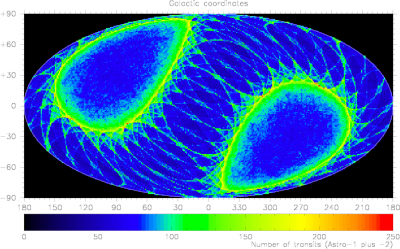Difference between revisions of "Detection system"
From Gaia Science Alerts Working Group
Jump to navigationJump to search| Line 14: | Line 14: | ||
** source motion flags | ** source motion flags | ||
** later in the mission: CU3, CU4, CU7 and CU8’s deliverables (information on motion, variability, astrophysical parameters) | ** later in the mission: CU3, CU4, CU7 and CU8’s deliverables (information on motion, variability, astrophysical parameters) | ||
| + | |||
| + | == Sampling properties of Gaia == | ||
| + | [[File:scanning_law_gal.png|400px|right|thumb|Number of observations per source over entire mission.]] | ||
| + | Detections will be strongly affected by sampling properties of the Gaia. These are induced by characteristic "scanning law" (see figure). | ||
| + | |||
== Photometric precision == | == Photometric precision == | ||
Revision as of 13:25, 6 November 2009
Detailed description (in draft version) of the Java code is available from Gaia WebSVN (Gaia password required), or here.
Detection
Detection will be conducted in almost entire range of available magnitudes from Gaia. Limiting magnitude for Gaia is equivalent of V=20mag, but for detection we will require signal above at least 19mag, to avoid spurious anomalies at high noise level. The saturation limit for Gaia is around 5 mag.
- Detection system employs the following data:
- G-flux observations - all available in given cycle
- accumulated G-flux: mean and scatter
- accumulated BP and RP colours
- low-dispersion BP and RP spectrometry
- morphology of the source
- source motion flags
- later in the mission: CU3, CU4, CU7 and CU8’s deliverables (information on motion, variability, astrophysical parameters)
Sampling properties of Gaia
Detections will be strongly affected by sampling properties of the Gaia. These are induced by characteristic "scanning law" (see figure).
Photometric precision
 From M. Varadi et al. 2009.
From M. Varadi et al. 2009.
Classification
At this stage all additional information from Gaia and later from other catalogues will be used for narrowing down the sample of interesting alerts.
